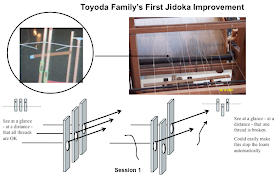The Toyota Production System is a house with
two pillars. One pillar represents just-in-time (JIT), and the other pillar the
concept of JIDOKA.
The house will not stand without both pillars.
Yet many of us focus on the mechanisms of implementation--one piece flow, pull
production, takt time, standard work, kanban--without linking those mechanisms
back to the pillars that hold up the entire system.
JIDOKA is the key to making the entire system stick.
•
Build in mechanisms to prevent mass-production of
defective work
•
Autonomous check for the
abnormal in a process
•
Machines with capability to
detect defects and respond accordingly
•
Transfer human intelligence
to automated machinery/systems.
•
Not limited to machine processes;
can be used with manual operations.
•
Human support system to
execute continuous improvement through prevention activities.
•
Illuminates the causes of
problems by stopping the process exactly as it was when a defects or
abnormality was detected
Never pass defects to next operation
•
Detecting
abnormalities
•
Responding
immediately
•
Eliminating
causes
Fig.
Why Jidoka must be
implemented?
•
Process capabilities.
•
Containment. Defects are quickly identified
and contained in the zone.
•
Feedback. So that quick countermeasures can be
taken.
(Catch the killer on the spot
is better then finding from the clue after escaped of the killer.)
Jidoka is one of the factors for the success of Lean implementation
•
High defect
rates lead to frequent line stoppages, which will make the flow and pull
difficult.
•
Defects will
jeopardize the takt time and make the process unevenness, increase lead time
and cost.
The root of the problem solving approach embedded in Jidoka thinking
is PDCA.
PDCA has its roots in the Scientific Method:
The scientific method has four steps
- Observation and description of a phenomenon or group of phenomena.
- Formulation of an hypothesis to explain the phenomena. In physics, the hypothesis often takes the form of a causal mechanism or a mathematical relation.
- Use of the hypothesis to predict the existence of other phenomena, or to predict quantitatively the results of new observations.
- Performance of experimental tests of the predictions by several independent experimenters and properly performed experiments.
Jidoka drives a four step process that engages when abnormalities
occur:
•
Detect the abnormality
•
Stop – bring attention to the problem
•
Fix or correct the immediate condition
•
Investigate the root cause and install a
countermeasure
Application of Jidoka
Fig.
A true human support system must be created as a part of any Jidoka
implementation.
•
The resources necessary to respond, fix, and root
cause analyze must be in place
•
Expectations of 5 W’s and 1 H defined and adhered to
•
Performance linked to expectations
Jidoka Benefits
•
Ensures & maintains
safety
•
Improved quality
•
Empowers people
•
Prevent defective items
being delivered to next production phase
•
Recognises abnormalities in
automated production so adjustments/repairs can be made quickly
•
Enables separation of
machine and human work
•
Eliminates the need for
operators to continuously watch machines just in case defects occur
•
Key driver for major gains
in productivity







Thank you so much for this post...
ResponderBorrarValue stream mapping
lean and six sigma training
The rating of Six Sigma can be identified by their belt program, and a Black Belt in Six Sigma is considered to be the top of the line, as far as quality processes go internationally.
ResponderBorrarLean six sigma certification in India